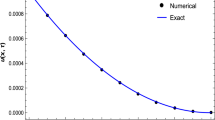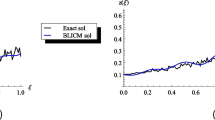Abstract
Temporal and spatial moment analysis of one-dimensional equations governing fate and transport of parent compounds along with their transformation products is useful for parameter estimation of model parameters, and for understanding the average attributes of contaminant behavior. The objective of this paper is to present analytical expressions for the lower order moments of members in a sequential chain reaction, where members undergo first-order decay to produce the next member in the chain. Specifically, moments up to second order are discussed for the first two members. For the case of purely advective transport (Peclet number tending to infinity), temporal moment expressions are provided for more members of the chain. The sensitivity of temporal moments is examined with respect to Peclet number and transformation rates. Spatial moments are derived by two methods—one using Fourier transforms and another using moment generating differential equations. The behavior of lower order moments for the first few members of a chain can be elucidated from their mathematical expressions. However, expressions for higher order moments tend to be very complicated especially for members further down the chain.








Similar content being viewed by others
References
Abulaban A, Nieber JL (2000) Modeling the effects of nonlinear equilibrium sorption on the transport of solute plumes in saturated heterogeneous porous media. Adv Water Resour 23(8):893–905
Aris R (1956) On the dispersion of a solute in a fluid flowing through a tube. Proc R Soc Lond A 235:67–77
Aris R (1958) On the dispersion of linear kinematic waves. Proc R Soc Lond A 245:268–277
Bromilow RH, Leistra M (1980) Measured and simulated behavior of aldicarb and its oxidation products in fallow soils. Pestic Sci 11(4):389–395
Castro CL, Rolston DE (1977) Organic phosphate transport and hydrolysis in soil: theoretical and experimental evaluation. Soil Sci Soc Am J 41(6):1085–1092
Cho CM (1971) Convective transport of ammonium with nitrification in soil. Can J Soil Sci 51(3):339–350
Cunningham JA, Goltz MN, Roberts PV (1999) Simplified expressions for spatial moments of groundwater contaminant plumes. J Hydrol Eng 4(4):377–380
Dagan G, Cvetkovic V (1993) Spatial moments of a kinetically sorbing solute plume in a heterogeneous aquifer. Water Resour Res 29(12):4053–4061
Das BS, Kluitenberg GJ (1996) Moment analysis to estimate degradation rate constants from leaching experiments. Soil Sci Soc Am J 60:1724–1731
Freyberg DL (1986) A natural gradient experiment on solute transport in a sand aquifer2 Spatial moments and the advection and dispersion of nonreactive tracers. Water Resour Res 22(13):2031–2046
Goltz MN, Roberts PV (1987) Using the method of moments to analyze three-dimensional diffusion-limited solute transport from temporal and spatial perspectives. Water Resour Res 23(8):1575–1585
Gureghian AB, Jansen G (1983) LAYFLO: a one dimensional semianalytical model for the migration of a three-member decay chain in a multilayered geologic medium: Technical Report ONWI-466, Office of Nuclear Waste Isolation, Battelle Memorial Institute, Columbus, OH, 83pp
Hantush MM, Govindaraju RS (2003) Theoretical development and analytical solutions of transport of volatile compounds in dual-porosity soils. J Hydrol 279:18–42
Hantush MM, Marino MA, Islam MR (2000) Models for leaching of pesticides in soils and groundwater. J Hydrol 227:66–83
Harada M, Chambre PL, Foglia M, Higashi K, Iwamoto F, Leung D, Pigford TH, Ding T (1980) Migration of radionuclides through sorbing media, analytical solutions—I: Report no. LBL-10500 (UC-11), Lawrence Berkeley Laboratory, University of California, Berkeley, 245 pp
Harvey FC, Gorelick SM (1995) Temporal moment-generating equations: modeling mass transport and mass transfer in heterogeneous aquifers. Water Resour Res 31:1895–1911
Higashi K, Pigford TH (1980) Analytical models for migration of radionuclides in geologic sorbing media. J Nucl Sci Tech 17(9):700–709
Hu BX, Deng FW, Cushman JW (1995) Nonlocal reactive transport with physical and chemical heterogeneity: linear nonequilibrium sorption with random K d . Water Resour Res 31(9):2239–2252
Kreft A, Zuber A (1978) On the physical meaning of dispersion equation and its solutions for different initial and boundary conditions. Chem Eng Sci 33:1471–1480
Rogers VC (1978) Migration of radionuclide chains in groundwater. Nucl Technol 40(3):315–320
Sardin M, Schweich D, Leij FJ, van Genuchten MTh (1991) Modeling the nonequilibrium transport of linearly interacting solutes in porous media: a review. Water Resour Res 27:2287–2307
Srivastava R, Sharma PK, Brusseau ML (2002) Spatial moments for reactive transport in heterogeneous porous media. ASCE J Hydrol Eng 7(4):336–341
Valocchi AJ (1989) Spatial moment analysis of the transport of kinetically adsorbing solutes through stratified aquifers. Water Resour Res 25(2):273–279
van Genuchten MTh (1985) Convective-dispersive transport of solutes involved in sequential first order decay reactions. Comput Geosci 11(2):129–147
van Genuchten MTh, Parker JC (1984) Boundary conditions for displacement experiments through short laboratory soil columns. Soil Sci Soc Am J 48:703–708
Wagenet RJ, Biggar JW, Nielsen DR (1976) Analytical solutions of miscible displacement equations describing the sequential microbiological transformations of urea, ammonium and nitrate: Research Report no. 6001, Department of Water Science and Engineering, University of California, Davis, 53pp
Author information
Authors and Affiliations
Corresponding author
Rights and permissions
About this article
Cite this article
Parashar, R., Govindaraju, R.S. Moment analysis for compounds undergoing sequential chain reactions with first-order decay. Stoch Environ Res Ris Assess 20, 95–105 (2006). https://doi.org/10.1007/s00477-005-0014-5
Published:
Issue Date:
DOI: https://doi.org/10.1007/s00477-005-0014-5




